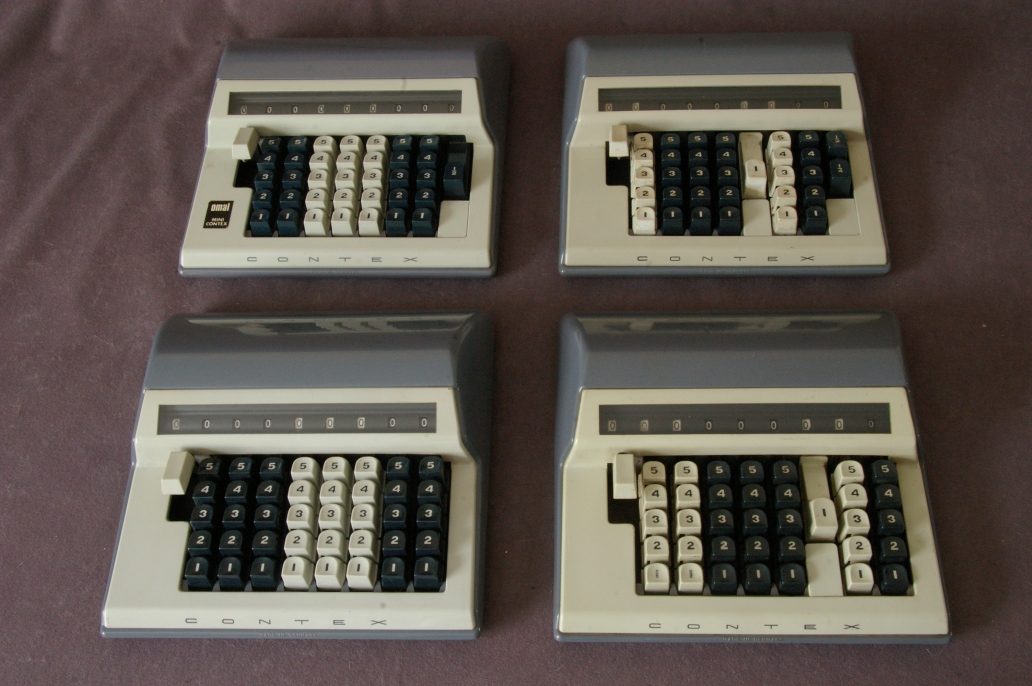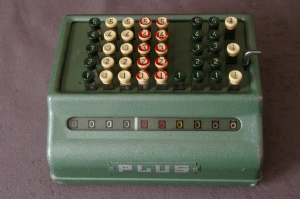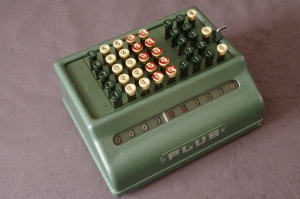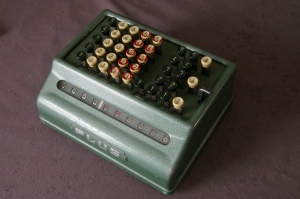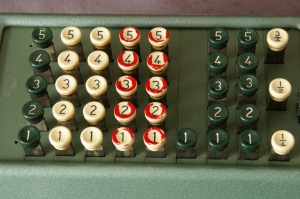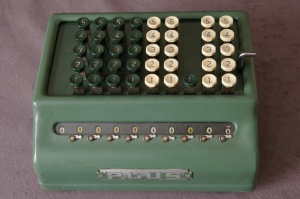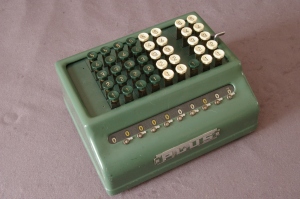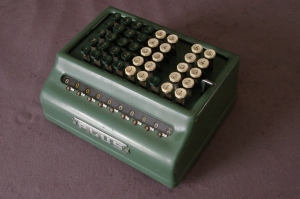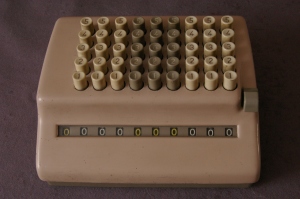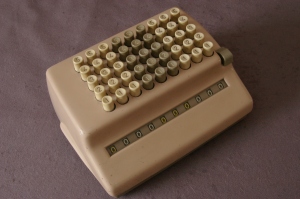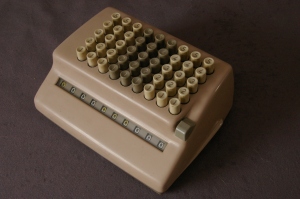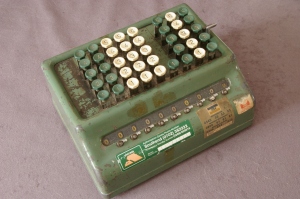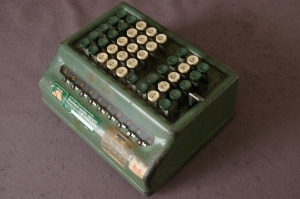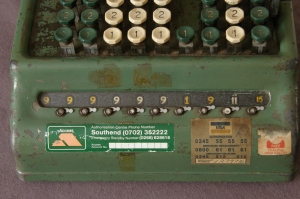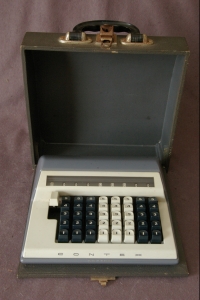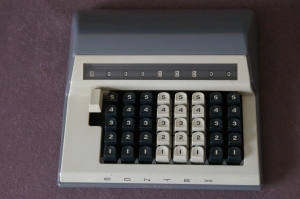When comptometers were used for adding, which apparently was about 90% of the time, operators were taught that it was more economical of movement to use repeated presses on the low number keys rather than reaching for the high numbers. In recognition of this fact, comptometer type machines were produced with abbreviated keyboards, such as the examples on this page.
“Plus” Adder Sterling Model with Farthings
Serial No. N/A
Date: 1950s
Maximum capacity: £99999 19s 11¾d
Price paid: £8.00
This machine is a Sterling currency machine. The leftmost five columns of keys are for entering whole pounds, the sixth column is for entering 10 shillings, the seventh column is for shillings below 10, the eighth column is for pennies, and the rightmost column is for farthings (quarter pennies). The UK abandoned farthings at the end of 1960, so the machine dates before then. The green hammertone finish places it firmly in the 1950s rather than earlier.
At some point in it life, this machine has been crudely converted to decimal currency, whereby the shillings, pennies and farthings columns are ignored, and the 10 shillings column is used as a half decimal penny column (and the numeral “1” on the 10 shillings number wheel has been overpainted with “½”). In this configuration, the maximum capacity of the machine is £999.99½.
“Plus” Adder Sterling Model with Whole Pennies
Serial No.
Date: 1950s
Maximum capacity: £999,999 19s 11d
Price paid: This machine was a very generous gift from Mr. Colin Jackson of Heptonstall, Yorkshire, along with the Triumphator Model KN and Brunsviga Model 20 shown elsewhere on this site.
The machine is a Sterling currency machine with whole pennies. One would be forgiven for thinking that the lack of farthings would date it to a period post-1960; however, this is probably not the case, since not all machines included farthings even when they were in circulation. For example, none of my collection of comptometers include farthings, though some date to much earlier than 1960.
The removal of the farthings column from the extreme right means that an additional pounds column could be added to the left hand side.
“Plus” Adder Decimal Model
Serial No. 509/D/868.483
Date: 1960s
Price paid (including postage): £22.10
This is a decimal machine dating to the late 1960s. The grouping of the colour coded decades is interesting – this clearly wasn’t intended for currency use, unless it was for estate agents 😉
“Plus” Adder Special – Mystery Machine!
Serial No. 509/SP/63.461
Date: 1950s
Price paid (including postage): £59.90
on the surface, this machine looks normal, but there is something strange about it. It is outwardly similar to the Sterling machine with farthings shown at the top of this page. However, the right hand column carries on 16. The remainder of the machine operates as a Sterling machine in whole pennies.
The fourth picture above shows the machine “fully loaded”, whereby adding a single digit the the rightmost column initiates a ripple carry across all of the registers.
Does anybody know what the last column would have been used for? Was there ever any need to subdivide pennies into sixteenths, as seems to be the case here?
“Plus” Adder Imperial Weights
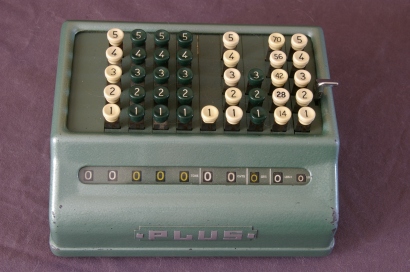
Serial No. 509/Y/205.260
Date: 1950s
Price paid (including postage): £84
Quite a rare beast, and accordingly quite expensive. This is a slightly unusual machine used for tallying weights. Columns are marked in pounds (lb), quarters of a hundred weight (qrs), hundredweight (cwt) and Imperial tons (ton). In the Imperial weights system, there are 112 pounds to a hundredweight, and 20 hundredweight to a ton. A quarter hundredweight is 28 pounds. There are therefore 2240 pounds to the ton. A metric ton (Tonne) wieghs aproximately 2205 pounds in comparision.
Contex Model B – Sterling Model, with Farthings
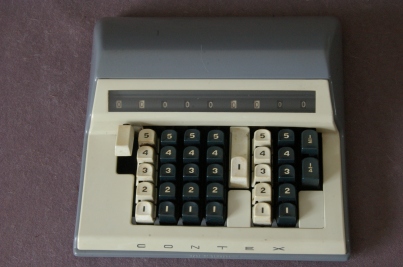
Serial No. 140858
Date: Before 1960
Price paid (including postage): £14.97
Contex were a Danish company who made a lot of these machines for Sterling currency calculations. They seem to have been especially popular in Australia, where Sterling currency was in use until 1966.
In the rightmost column are the half penny and farthing (quarter penny) keys. The next column to the left is for pennies, and the one after that (in white) is for shillings. The single key is for entering amounts of ten shillings. To the left of the 10 shillings key are the four columns for entering pounds. The total capacity of the machine is £9,999 19s 11d + three farthings. The reset key is on the left.
The machines have a lightweight and flimsy feel about them, but they seem to be fairly robust.
Contex Model B – Sterling Model with Whole Pennies
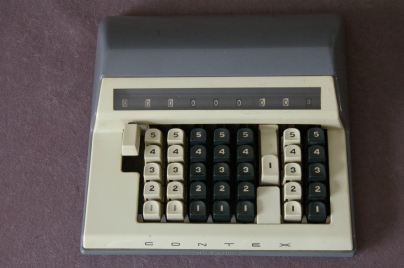
Serial No. 246818
Date: 1960s
Price paid (including postage): £31.99
The difference between this machine and the previous example is that the half penny and farthings keys have been removed. The opportunity has been taken to increase the number of pounds columns, increasing the capacity of the machine to £99,999 19s 11d.
Contex Model B – Decimal Model with Half Pennies
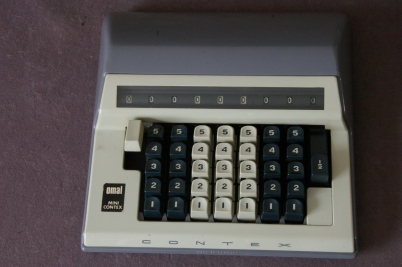
Serial No.
Date: 1970s
Price paid (including postage):
Contex Model B – Decimal Model with Whole Pennies
Serial No. 945937
Date: 1970s
Price paid (including postage): £29.71
This is a decimal version of the Contex Model B. The 10 shillings key has been replaced by a pounds column, and the rightmost column counts 10 decimal pennies instead of 12 pre-decimal ones. It wasn’t long after this machine was built that mechanical calculators became obsolete.
Contex Model B Family
